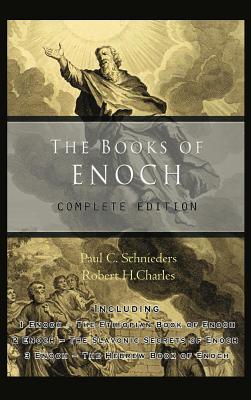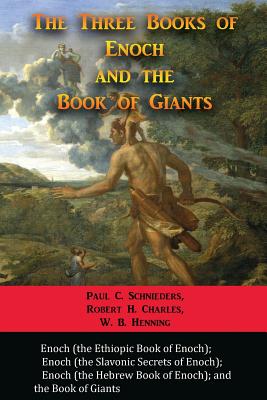


This book contains the three most-known books attributed to Enoch. It also includes an extensive introduction showing the history of the books etc.
1st Book of Enoch, the Ethiopic Book of Enoch, or 1 Enoch, which is more known as simply the Book of Enoch. Although this book is considered apocryphal for the Western canon, it is contained in the Ethiopic Bible. It was considered sacred by some important first followers of Christ but it was left out of the Bible and disappeared for centuries until it was rediscovered in 1773 in Ethiopic. This manuscript was first translated into English in the 1820s and into German in the 1830s. According to most scholars, part of it was written in third century BCE and part of it in the first century CE (the part related to the Son of Man). Although the oldest complete copies of 1 Enoch are K-9 or Kebran 9, dated late fourteenth early fifteenth century and Ethiopian Monastic Microfilm Library (EMML 2080) of the fifteenth or fourteenth century, fragments found in Qumram in the 1950s are more than 2000 years old. Other old important manuscripts are Abbadianus 55 (possibly fifteenth century) and British Museum Orient 485 (first half of the sixteenth century).
2nd Book of Enoch, the Slavonic Enoch, or 2 Enoch, which is another apocryphal book, found complete only in Old Slavonic manuscripts, and it was once present in the Old Slavonic Bible. It's usually dated to the first century CE although Matthew Black in The Oxford Guide to People & Places of the Bible state that there is no manuscript earlier than the fourteenth century BE.
3rd Book of Enoch, the Hebrew Enoch, or 3 Enoch, which is a Rabbinic text in Hebrew usually dated to the fifth century CE. Some experts believe it was written by Rabbi Ishmael (second century CE), familiar with both 1 Enoch and 2 Enoch.

This book includes 1 Enoch: The Ethiopic Book of Enoch; 2 Enoch: The Slavonic Book of the Secrets of Enoch; 3 Enoch: The Hebrew Book of Enoch; and versions of the Book of Giants.
The 1st Book of Enoch, the Ethiopic Book of Enoch, or 1 Enoch is more known as simply the Book of Enoch. Although this book is considered apocryphal for the Western canon, it is contained in the Ethiopic Bible. It was considered sacred by some important first followers of Christ but it was left out of the Bible and disappeared for centuries until it was rediscovered in 1773 in Ethiopic. This manuscript was first translated into English in the 1820s and into German in the 1830s. According to most scholars, part of it was written in third century BCE and part of it in the first century CE (the part related to the Son of Man). Although the oldest complete copies of 1 Enoch are K-9 or Kebran 9, dated late fourteenth early fifteenth century and Ethiopian Monastic Microfilm Library (EMML 2080) of the fifteenth or fourteenth century, fragments found in Qumram in the 1950s are more than 2000 years old. Other old important manuscripts are Abbadianus 55 (possibly fifteenth century) and British Museum Orient 485 (first half of the sixteenth century).
The 2nd Book of Enoch, the Slavonic Enoch, or 2 Enoch, is another apocryphal book, found complete only in Old Slavonic manuscripts, and it was once present in the Old Slavonic Bible. It's usually dated to the first century CE although Matthew Black in The Oxford Guide to People & Places of the Bible state that there is no manuscript earlier than the fourteenth century BE.
The 3rd Book of Enoch, the Hebrew Enoch, or 3 Enoch, is a Rabbinic text originally written in Hebrew usually dated to the fifth century CE. Some experts believe it was written by Rabbi Ishmael (second century CE), familiar with both 1 Enoch and 2 Enoch.
The Book of Giants contains a narrative that involves the antediluvian giant offspring originally known from both the Genesis and the Book of Enoch. The Book of Giants resembles particularly 1 Enoch: The First Book of Enoch.

This translation contains all 3 Books of Enoch:
1) 1 Book of Enoch (Also called The Ethiopic Book of Enoch)
2) 2 Book of Enoch (Also called The Slavonic Book of Enoch, The Secrets of Enoch).
Also contains the extended version of 2 The Book of Enoch, The Exaltation of Melchizedek.
3) 3 Book of Enoch (Also called The Hebrew Book of Enoch)
Although this book is considered apocryphal for the Western canon, it is contained in the Ethiopic Bible. It was considered sacred by some but it was left out of the Bible and disappeared for centuries until it was rediscovered in Ethiopic. According to most scholars, part of it was written in third century BCE and part of it in the first century CE (the part related to the Son of Man). Although the oldest complete copies of 1 Enoch are K-9 or Kebran 9, dated late fourteenth early fifteenth century and Ethiopian Monastic Microfilm Library (EMML 2080) of the fifteenth or fourteenth century, fragments found in Qumramin the 1950s are more than 2000 years old. Other old important manuscripts are Abbadianus 55 (possibly fifteenth century) and British Museum Orient 485 (first half of the sixteenth century).
The 2nd Book of Enoch, the Slavonic Enoch, is another apocryphal book, found complete only in Old Slavonic manuscripts, and it was once present in the Old Slavonic Bible. It's usually dated to the first century CE although Matthew Black in The Oxford Guide to People & Places of the Bible state that there is no manuscript earlier than the fourteenth century BCE.
The 3rd Book of Enoch, the Hebrew Enoch, is a Rabbinic text originally written in Hebrew usually dated to the fifth century CE. Some experts believe it was written by Rabbi Ishmael (second century CE).

This book includes 1 Enoch: The Ethiopic Book of Enoch; 2 Enoch: The Slavonic Book of the Secrets of Enoch; 3 Enoch: The Hebrew Book of Enoch; and versions of the Book of Giants.
The 1st Book of Enoch, the Ethiopic Book of Enoch, or 1 Enoch is more known as simply the Book of Enoch. Although this book is considered apocryphal for the Western canon, it is contained in the Ethiopic Bible. It was considered sacred by some important first followers of Christ but it was left out of the Bible and disappeared for centuries until it was rediscovered in 1773 in Ethiopic. This manuscript was first translated into English in the 1820s and into German in the 1830s. According to most scholars, part of it was written in third century BCE and part of it in the first century CE (the part related to the Son of Man). Although the oldest complete copies of 1 Enoch are K-9 or Kebran 9, dated late fourteenth early fifteenth century and Ethiopian Monastic Microfilm Library (EMML 2080) of the fifteenth or fourteenth century, fragments found in Qumram in the 1950s are more than 2000 years old. Other old important manuscripts are Abbadianus 55 (possibly fifteenth century) and British Museum Orient 485 (first half of the sixteenth century).
The 2nd Book of Enoch, the Slavonic Enoch, or 2 Enoch, is another apocryphal book, found complete only in Old Slavonic manuscripts, and it was once present in the Old Slavonic Bible. It's usually dated to the first century CE although Matthew Black in The Oxford Guide to People & Places of the Bible state that there is no manuscript earlier than the fourteenth century BE.
The 3rd Book of Enoch, the Hebrew Enoch, or 3 Enoch, is a Rabbinic text originally written in Hebrew usually dated to the fifth century CE. Some experts believe it was written by Rabbi Ishmael (second century CE), familiar with both 1 Enoch and 2 Enoch.
The Book of Giants contains a narrative that involves the antediluvian giant offspring originally known from both the Genesis and the Book of Enoch. The Book of Giants resembles particularly 1 Enoch: The First Book of Enoch.

This translation contains all 3 Books of Enoch:
1) 1 Book of Enoch (Also called The Ethiopic Book of Enoch)
2) 2 Book of Enoch (Also called The Slavonic Book of Enoch, The Secrets of Enoch).
Also contains the extended version of 2 The Book of Enoch, The Exaltation of Melchizedek.
3) 3 Book of Enoch (Also called The Hebrew Book of Enoch)
Although this book is considered apocryphal for the Western canon, it is contained in the Ethiopic Bible. It was considered sacred by some but it was left out of the Bible and disappeared for centuries until it was rediscovered in Ethiopic. According to most scholars, part of it was written in third century BCE and part of it in the first century CE (the part related to the Son of Man). Although the oldest complete copies of 1 Enoch are K-9 or Kebran 9, dated late fourteenth early fifteenth century and Ethiopian Monastic Microfilm Library (EMML 2080) of the fifteenth or fourteenth century, fragments found in Qumramin the 1950s are more than 2000 years old. Other old important manuscripts are Abbadianus 55 (possibly fifteenth century) and British Museum Orient 485 (first half of the sixteenth century).
The 2nd Book of Enoch, the Slavonic Enoch, is another apocryphal book, found complete only in Old Slavonic manuscripts, and it was once present in the Old Slavonic Bible. It's usually dated to the first century CE although Matthew Black in The Oxford Guide to People & Places of the Bible state that there is no manuscript earlier than the fourteenth century BCE.
The 3rd Book of Enoch, the Hebrew Enoch, is a Rabbinic text originally written in Hebrew usually dated to the fifth century CE. Some experts believe it was written by Rabbi Ishmael (second century CE).